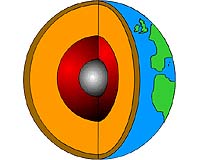| . |  |
. |
Salt Lake City UT (SPX) Feb 26, 2010 A team of paleontologists has discovered a new dinosaur species they're calling Abydosaurus, which belongs to the group of gigantic, long-necked, long-tailed, four-legged, plant-eating dinosaurs such as Brachiosaurus. In a rare twist, they recovered four heads - two still fully intact - from a quarry in Dinosaur National Monument in eastern Utah. Complete skulls have been recovered for only eight of more than 120 known varieties of sauropod. "Their heads are built lighter than mammal skulls because they sit way out at the end of very long necks," said Brooks Britt, a paleontologist at Brigham Young University. "Instead of thick bones fused together, sauropod skulls are made of thin bones bound together by soft tissue. Usually it falls apart quickly after death and disintegrates." Britt is a co-author on the discovery paper scheduled to appear in the journal Naturwissenshaften. The lead author is Daniel Chure, a paleontologist at Dinosaur National Monument, who has no trouble boiling down the significance of the discovery. "We've got skulls!" he shouted with sweeping hand gestures during a recent visit to the site. BYU geology students and faculty resorted to jackhammers and concrete saws to cut through the hardened 105-million-year-old sandstone containing the bones. At one point the National Park Service called in a crew to blast away the overlying rock with explosives. The skulls are temporarily on display at BYU's Museum of Paleontology, where visitors can also watch BYU students prepare other bones from Abydosaurus. "The hardest bone I personally have worked on is a vertebra that was half-eroded before discovery and is so fragile that it crumbles if you look at it wrong," said Kimmy Hales, a geology major studying vertebrate paleontology at BYU. "The funnest project I have worked on was a set of five toe bones. Each toe bone was larger than my hand." Analysis of the bones indicates that the closest relative of Abydosaurus is Brachiosaurus, which lived 45 million years earlier. The four Abydosaurus specimens were all juveniles. Most of what scientists know about sauropods is from the neck down, but the skulls from Abydosaurus give a few clues about how the largest land animals to roam the earth ate their food. "They didn't chew their food; they just grabbed it and swallowed it," Britt said. "The skulls are only one two-hundredth of total body volume and don't have an elaborate chewing system." All sauropods ate plants and continually replaced their teeth throughout their lives. In the Jurassic Period, sauropods exhibited a wide range of tooth shapes. But by the end of the dinosaur age, all sauropods had narrow, pencil-like teeth. Abydosaurus teeth are somewhere in between, reflecting a trend toward smaller teeth and more rapid tooth replacement. The fossils were excavated from the Cedar Mountain Formation in Dinosaur National Monument near Vernal, Utah. The site is just a quarter of a mile away from the condemned visitor center that displays thousands of bones that remain in place on an uplifted slab of sandstone. University of Michigan researchers John Whitlock and Jeffrey Wilson are also co-authors on the study. What's in the name Abydosaurus mcintoshi? The generic name refers to Abydos, the Greek name for the city along the Nile River (now El Araba el Madfuna) that was the burial place of the head and neck of Osiris, Egyptian god of life, death and fertility. Abydos alludes to the type specimen, which is a skull and neck found in a quarry overlooking the Green River. Sauros is the Greek word for lizard. The specific name mcintoshi honors the American paleontologist Jack McIntosh for his contributions to the study of sauropod dinosaurs. In 1975 McIntosh debunked the myth of Brontosaurus, exposing it as a mixed-up skeleton with an Apatosaurus body and a Camarasaurus skull.
Share This Article With Planet Earth
Related Links Brigham Young University Explore The Early Earth at TerraDaily.com
 Upside-Down Answer For Deep Earth Mystery
Upside-Down Answer For Deep Earth MysteryHouston TX (SPX) Feb 18, 2010 When Earth was young, it exhaled the atmosphere. During a period of intense volcanic activity, lava carried light elements from the planet's molten interior and released them into the sky. However, some light elements got trapped inside the planet. In this week's issue of Nature, a Rice University-based team of scientists is offering a new answer to a longstanding mystery: What caused Earth to h ... read more |
|
| The content herein, unless otherwise known to be public domain, are Copyright 1995-2010 - SpaceDaily. AFP and UPI Wire Stories are copyright Agence France-Presse and United Press International. ESA Portal Reports are copyright European Space Agency. All NASA sourced material is public domain. Additional copyrights may apply in whole or part to other bona fide parties. Advertising does not imply endorsement,agreement or approval of any opinions, statements or information provided by SpaceDaily on any Web page published or hosted by SpaceDaily. Privacy Statement |